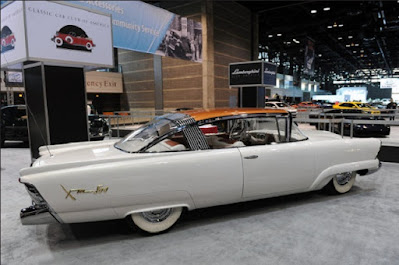⛔ Hidden GEMS 💣
- The mid-1950s witnessed a pivotal era in American automotive history,
marked by a fierce determination among manufacturers to craft sports
cars rivaling their European counterparts. Notable among these
aspirations were the Ford Thunderbird, GM Corvette, and Kaiser Darrin, alongside the hidden gem of automotive ingenuity—the Mercury XM 800 along with its sibling, the Mercury XM Turnpike Cruiser concepts.
 |
| The 1954 Ford Mercury XM 800 was crafted in Ford Motor's Mercury pre-production studio by visionary designers including John Najjar (studio manager) and Elwood Engle (consultant from George Walker's design firm). (Picture from: RodAuthority) |
Designed within Ford Motor's Mercury pre-production studio by visionaries like John Najjar (studio manager) and Elwood Engle (consultant assigned to Ford by George Walker's design firm), the XM 800 debuted at the 1954 Detroit Auto Show, captivating audiences with its futuristic allure. Constructed by Creative Industries in Detroit, this concept car stood as a testament to Mercury's pioneering spirit in automotive design.
 |
| The 1954 Ford Mercury XM 800 boasted distinctive features such as forward-slanted hooded headlights, concealed front wheels, and a sleek rear design adorned with slender, canted taillights. (Picture from: Conceptcarz) |
 |
| The 1954 Ford Mercury XM 800's interior showcases an aviation-inspired design, complete with a wide wraparound windshield and flush-type door handles, all in pearlescent white and copper tones, creating a timeless appeal. (Picture from: Carstyling.ru) |
 |
| The 1954 Ford Mercury XM 800 powered by a 5.112 cc or 312 cubic inch engine which is combined with the Ford-O-Matic transmission system to deliver about 266 PS of power to the rear wheels. (Picture from: RodAuthority) |
While the XM 800 never entered mass production, it was envisioned as a contender against Buick, Oldsmobile, and Pontiac, underscoring its potential as a second Mercury car line. However, shifts in strategic planning, including the emergence of the Ford Edsel, led to the XM 800 remaining a visionary concept rather than a commercial reality.
 |
| The 1954 Ford Mercury XM 800 while sat on display at the 2012 Chicago Auto Show. (Picture from: RodAuthority) |
The XM 800 transcended the automotive world, featuring briefly in the 1954 film "Woman's World" and becoming a sought-after collectible via miniature versions in cereal boxes by the F & F Mold Company. Later, it was housed in the University of Michigan's Automotive Engineering Lab before finding a permanent place in the prestigious Bortz Dream Car Collection. This journey underscores its enduring legacy in automotive history, with experts considering it one of the most attractive concept cars, valued at around $429,000 (approximately Rp. 3.85 billion).
 In 2012, the XM 800 concept car re-emerged, elegantly displayed among modern vehicles at the Chicago Auto Show. From conception to rediscovery, the Mercury XM 800 embodies innovation, inspiring
generations of automotive enthusiasts and designers with its timeless design excellence and creative spirit. *** [EKA [04112020] | FROM VARIOUS SOURCES | CARSTYLING.RU | AUTOBLOG | ROD AUTHORITY | CONCEPTCARZ ]
In 2012, the XM 800 concept car re-emerged, elegantly displayed among modern vehicles at the Chicago Auto Show. From conception to rediscovery, the Mercury XM 800 embodies innovation, inspiring
generations of automotive enthusiasts and designers with its timeless design excellence and creative spirit. *** [EKA [04112020] | FROM VARIOUS SOURCES | CARSTYLING.RU | AUTOBLOG | ROD AUTHORITY | CONCEPTCARZ ]Note: This blog can be accessed via your smart phone
































